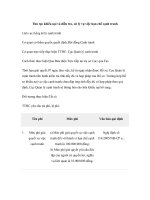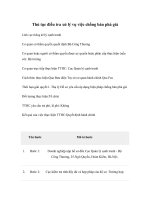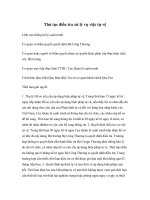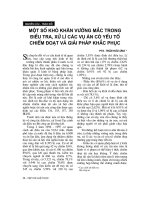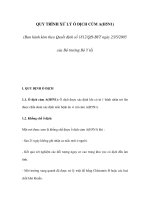Điều tra xử lý vụ dịch Outbreak investigation
Bạn đang xem bản rút gọn của tài liệu. Xem và tải ngay bản đầy đủ của tài liệu tại đây (1.01 MB, 16 trang )
Phạm Văn Hậu
Viện Pasteur TP. HCM
/>
Trung tâm y tế dự phòng tỉnh
• Chuông điện thoại vang lên vào thời điểm
gần hết giờ làm việc của chiều thứ 6
• Giọng nói hốt hoảng của đồng nghiệp
“Có 4 BN của 1 nhà máy tại địa phương
mắc SARS nhập viện”
• Chúng ta cần phải hành động trước vấn
đề này
HÀNH ĐỘNG GÌ ĐÂY ?
Vụ dịch:
Điều tra – Xử lý
Khái niệm
• Bệnh địa phương (Endemic disease)
• Dịch (Outbreak / Epidemic)
• Đại dịch (Pandemic)
• Giám sát (surveillance)
Bệnh địa phương
• Một bệnh truyền nhiễm xuất hiện liên tục
• Trong một khu vực địa lý hoặc một nhóm
dân cư
• Ví dụ:
A Dictionary of
Epidemiology, 6th
Edition,
- International
Epidemiological
Association
- Edited by Miquel
Porta
Vụ dịch là gì?
Gia tăng số mắc mới của một bệnh
– Trong 1 địa phương nào đó
– Trong 1 khoảng thời gian nào đó
– Trong 1 nhóm người nào đó
Đại dịch
“Lưu hành địa phương” - “dịch”
“Lưu hành
Số BN
Dịch ở quy mô rộng / xuyên quốc gia
địa phương”
Dịch gây số mắc ít nhưng tác nhân
“Dịch”
nguy hiểm
Thời gian
Giám sát là gì ?
Systematic and continuous collection, analysis,
and interpretation of data, closely integrated with
the timely and coherent dissemination of the
results and assessment to those who have the
right to know so that action can be taken. It is an
essential feature of epidemiological and public
health practice. The final phase in the
surveillance chain is the application of
information to health promotion and to disease
prevention and control. A surveillance system
includes a functional capacity for data collection,
analysis, and dissemination linked to public
health programs.
Pandemic influenza preparedness and response - WHO guidance document
Giám sát là gì ?
Mục tiêu
• Tổng quan về các bài học
Thu thập
Phân tích
dữ liệu (Hệ thống và liên tục)
Diễn giải
• Làm nổi bật cách tiếp cận có hệ thống
về điều tra dịch
• Định nghĩa các bước điều tra dịch
Phân bố kết quả kịp thời đến cá nhân, cơ
quan chức năng
Hành động kịp thời
Dịch: diễn biến tự nhiên
Dịch: diễn biến tự nhiên
Số
BN
Số
BN
Thời gian
(ngày/tuần)
Thời gian
(ngày/tuần)
First
case
Dịch: phát hiện và đáp ứng
BN đầu tiên
Phát
hiện
Dịch:
Phát hiện và
đáp ứng trễ
Đáp
ứng
Số người có thể
phòng được
1
Số BN có thể phòng
Số
BN
Late
Delayed
detection response
90
80
70
60
CASES 50
40
30
20
10
0
5
9
Early
detection
13
17
21
25
90
80
33
37
DAY
Số người có thể
phòng được
First
70
case
60
Thời gian
(ngày/tuần)
29
Prompt
response
50
Dịch:
CASES 40
Phát hiện và
30
đáp ứng kịp thời 2010
0
1
Mục tiêu của điều tra
Mục tiêu của
CAN THIỆP :
Giảm số người mắc
bệnh
Phá vỡ đường truyền
bệnh
Mục tiêu của
ĐIỀU TRA:
Xác định tác nhân gây
dịch
Xác định nguồn bệnh có
thể
Investigation
5
17
21
25
29
33
Dead
Surveillance
37
DAY
Sick
Exposed
Dịch tễ
Lâm sàng
An toàn
thực phẩm
Xét nghiệm
Vector
Reservoir
Supply
channels
Clinical
Specimen
transfer
Investigation
Diagnostic
Media
Xác định hình thức lan
truyền dịch
13
Prediction
Trace
back
Phòng các vụ dịch
trong tương lai
9
Authorities
Decisions
Infrastructure
Regulations
Vaccinations etc
Điều tra
Tử vong
Giám sát
Bệnh
Phơi
nhiễm
Dự báo
Lâm sàng
Dịch tễ
Chuỗi
Cung ứng
Hồi cứu
An toàn
Thực phẩm
Xét nghiệm
Truyền
thông
Exposed
Cơ quan
chức năng
Clinicians
Co-ordination
Food safety
Lâm sàng
Supply
channels
Chẩn đoán
Tác nhân
Vận chuyển
mẫu
Trace
back
• Phối hợp đa ngành
• Triển khải tại thực địa
Tiếp cận
một cách hệ thống
Specimen
transfer
Diagnostic
Authorities
Decisions
Các bước điều tra dịch
Yêu cầu cụ thể khi điều tra dịch
• Phòng chống nhanh chóng
Clinical
Infrastructure
Regulations
Vaccinations etc
Hạ tầng cơ sở
Văn bản
Vắc xin …
• Hành động kịp thời
Laboratory
Investigation
Media
Chính sách
• Sự kiện khác thường
Sick
Prediction
Vector
Reservoir
Điều tra
Dead
Surveillance
Epidemiology
Phối hợp
Vector
Nguồn bênh
Investigation
Khẳng địch vụ dịch và chẩn đoán
Thành lập đội điều tra dịch
Đinh nghĩa trường hợp bênh
Xác định trường hợp bệnh và thu
thập thông tin
5. Mô tả: Người, nơi chốn, địa điểm
6. Phát triển giả thuyết
7. Kiểm định giả thuyết
8. Nghiễn cứu thêm vào
9. Thực hiện các biện pháp can thiệp
10. Truyền thông kết quả
1.
2.
3.
4.
WHO / CDC
/>gation%20Foldout.pdf
/>
Khẳng định vụ dịch
Có phải vụ dịch không
• More cases than expected?
• Surveillance data
• Surveys: hospitals, labs, physicians
Chú ý !
•
•
•
•
Seasonal variations
Notification artefacts
Diagnostic bias (new technique)
Diagnostic errors (pseudo-outbreaks)
Khẳng định vụ dịch
•
•
•
•
•
•
Review the clinical findings
Examine some cases
Meet attending physicians
Review the lab findings
Contact the laboratories
Obtain additional lab specimens
Not always necessary to confirm all the cases
but confirm a proportion
throughout the outbreak
Outbreak confirmed,
further investigations warranted
Outbreak confirmed
Immediate control
measures?
- prophylaxis
- isolation
- public warning
- hygienic measures
- others
Further
investigation?
- causative agent
- mode of transmission
- vehicle of transmission
- source of contamination
- population at risk
-exposure causing illness
-others
Dịch tễ học mô tả
- Who are the cases? (Person)
Form Outbreak
Control Team
Team coordinates
field investigation
Epidemiologist
Microbiologist
Clinician
Environmentalist
Engineers
Veterinarians
Others
- Where do they live? (Place)
- When did they become ill? (Time)
Định nghĩa trường hợp bệnh
Standard set of criteria for deciding if a person
should be classified as suffering from the
disease under investigation
Các chú ý trong định nghĩa
trường hợp bênh
• Simple, practical, objective
• Sensitive?
• Specific?
Tam giác
dịch tễ học
• Epidemiology + Clinical + Lab
1. Person
2. Place
3. Time
Độ nhậy và độ đặc hiệu
• Ideally, a case definition will include all cases
(high sensitivity) but exclude any person
have not the illness (high specificity).
• Sensitive case: detect many cases but may
also count as cases individuals who do not
have the disease.
• Specific cases: to include only persons who
truly have the disease under investigation
but also more likely to miss some cases.
Multiple case definition
• Confirmed cases
• Probable cases
• Possible cases
Case definitions
Identify &
count cases
• Confirmed cases: laboratory result (+)
(isolation of the causative agent or positive
serological test). This case definition has
high specificity.
• Probable cases: have the typical clinical
features of the illness but without laboratory
confirmation.
• Possible cases: have fewer or atypical
clinical features. This case definition has
high sensitivity.
notifications
hospitals, GPs
laboratories
schools
workplace, etc
Organize information: Line list
Identify &
count cases
Obtain
information
Identifying information
Demographic information
Clinical details
Exposures and known
risk factors
•
•
•
•
•
•
•
Names
Date of birth
Address
Onset of symptoms
Treating physician
Hospital stay
Laboratory results
Line List
Case
No.
Name
1
2
3
4
5
6
XY
AB
CD
…
…
…
Date
of birth
Lab
results
Date of
onset
Address
Identify &
count cases
Obtain
information
Analysis of
descriptive data
Examples of Epicurves
Time: Epi curve
• Describe
– start, end, duration
9
cases
8
7
6
5
4
3
2
– importance
1
0
cases
10
9
6
8
7
6
5
4
5
4
3
2
3
2
1
2
– atypical cases
• Helps to develop hypotheses
incubation period
etiological agent
type of source
type of transmission
time of exposure
Common persistent
source
Common point source
Cases 10
– peak
–
–
–
–
–
Describe in
- time
- place
- person
3
4
5
6
7
8
9
10
11
12
1
1
0
0
1
2
3
4
5
6
7
8
1
hours
Days
12
3
4
5
6
7
8
9
10
11
12
days
Propagated source
cases
2
10
cases
10
9
8
7
6
8
6
Common
intermittent source
5
4
3
2
4
2
1
0
0
1
2
3
4
5
6
7
weeks
8
9
10
11
12
13
1 2 3 4 5 6 7 8 9 10 11 12 13 14 15 16 17 18 19 20 21 22
days
Nơi chốn
• Nơi ở
• Nơi có thể phơi nhiễm: nơi làm việc,
ăn, đi du lịch, hoạt động
– meals
– travel routes
– day-care
– leisure activities
• Bản đồ
– identify an area at risk
John Snow maps
Using maps
Person
• Distribution of cases
– age
– sex
– occupation, etc
• Distribution of these variables in population
• Attack rates
Compare hypotheses
with facts
Test specific hypotheses
Analytical studies
- cohort studies
- case-control studies
Phát triển giả thuyết
• Ai có nguy cơ mắc bệnh ?
• Bệnh gì?
• Nguồn bệnh và trung gian truyền bệnh?
• Kiểu lây truyền?
Kiểm định giả thuyết
• Cohort
- attack rate exposed group
- attack rate unexposed group
• Case control
- proportion of cases exposed
- proportion of controls exposed
Verify hypothesis
Additional investigations
• Microbiological investigation of food
samples
• Environmental investigation
• Veterinarian investigation
• Molecular Typing
• Trace back investigations (origin of foods)
• Meteorological data
• Entomological investigations
Báo cáo vụ dịch
• Regular updates during the investigation
• Detailed report at the end
– communicate public health messages
– influence public health policy
– evaluate performance
– training tool
– legal proceedings
Triển khai các biện pháp
chống dịch
May (must) occur at any
time during the outbreak!!
At first, general measures
According to findings,
more specific measures
1) Control the source of pathogen
2) Interrupt transmission
3) Modify host response
The reality….
Steps of an outbreak investigation
1.
2.
3.
4.
5.
6.
7.
8.
9.
10.
Confirm outbreak and diagnosis
Form Outbreak Control Team
Define a case
Identify cases and obtain information
Describe data by time, place, person
Develop hypothesis
Test hypothesis: analytical studies
Additional studies
Implement control measures
Communicate results
Cảm ơn các bạn
đã quan tâm theo dõi
time
Confirmation
Site visit
Recommendations
Case definition
Organize Data
Confirm Diagnosis
Info:
Outbreak
suspected Form Outbreak
Control Team
Report
Publication
Descripitve
Epidemiology
Line list
Analytic
Epidemiology
Control measures

